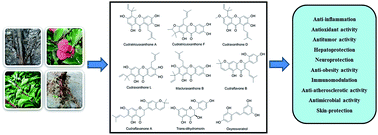Cudrania tricuspidata: an updated review on ethnomedicine, phytochemistry and pharmacology
Abstract
Cudrania tricuspidata is a perennial plant of the family Moraceae with numerous medicinal and nutritional applications. It has been widely used in East Asia as an important traditional folk medicine for the treatment of many ailments such as eczema, mumps, tuberculosis, contusions, insomnia and acute arthritis. The whole plant of C. tricuspidata, including the roots, leaves, bark, stems and fruits, has been found to contain diverse phytochemicals, including xanthones, flavonoids, organic acids, and polysaccharides, with various bioactivities. In particular, xanthones and flavonoids, as the main active constituents, isolated from C. tricuspidata have been proven to possess notable anti-inflammatory, antioxidative, antitumor, hepatoprotective, neuroprotective and anti-obesity effects. This review summarizes the botany, traditional uses, phytochemistry and pharmacology of C. tricuspidata, and the limitations of studies on this species have also been discussed such that to serve as the basis for further research and development on this medicinal plant.

- This article is part of the themed collection: 2017 Review articles


 Please wait while we load your content...
Please wait while we load your content...